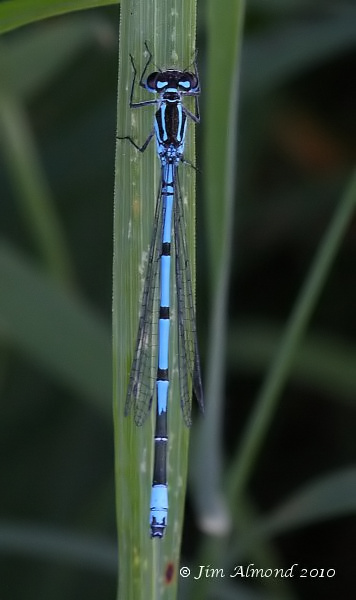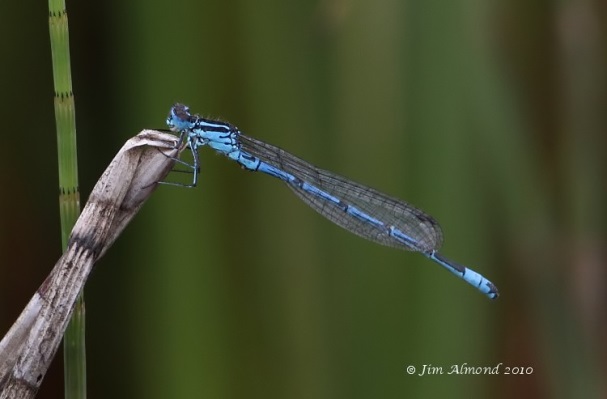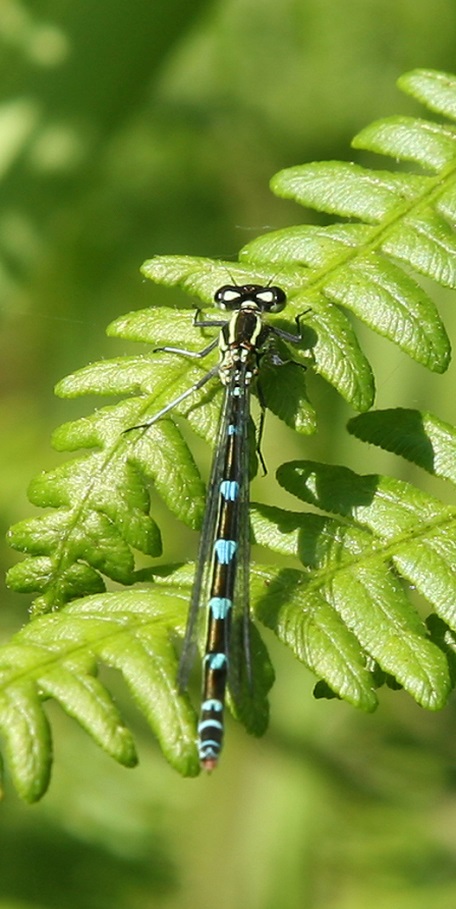Name
Coenagrion puella (Linnaeus, 1758)
Family:
Coenagrionidae
Status in Britain and Ireland:
common and widespread except in Scotland
Local Status:
common
Size:
Overall body length 33-35mm
Hindwing length 15-24mm
Flight period:
Mid May until early August
Photograph © J. Almond
Male Azure Damselfly
The body is bright blue. Narrow blue antehumeral stripes are present on the thorax. On the side of the thorax are 2 narrow black lines. The top line is incomplete and described as a spur. On segment 2 there is a black U shape. On segment 9 there is a black bowtie shaped mark. Eyes are blue. Wings are clear with a black pterostigma. Legs are black with a blue line down the femur. The male is described as a snooker player with a cue (spur on thorax), bowtie (segment 9) and beer glass (segment 2). A side view of the male is shown in additional photographs at the bottom of the page.
Female green form. Photograph © B. Smith
Female Azure Damselfly
There are 2 female forms, a green form and a far less common blue form (shown in additional photographs at the bottom of the page). The body of the green form is mainly black dorsally with yellow-green visible between segments 3-7 and blue between segments 7-10. On segment 2 there is a thistle head pattern in black. The blue form also has the thistle head pattern, but has less black on abdominal segments3-6 where the blue bands are wider. Eyes are blue or green respectively as is the stripe on the femur.
Similar Species
In Shropshire confusion is most likely between this species and Common Blue Damselfly and Variable Damselfly. Male Common Blue Damselflies have a ‘lollipop’ shape on segment 2, no spur on the side of the thorax, far broader antehumeral stripes and solid blue segments 8 and 9 with no black bowtie shape. Male Variable Damselflies have a goblet shape on segment 2, a more extensive black mark on segment 9 and broken antehumeral stripes. On close inspection the trailing edge of the pronotum is more deeply lobed in Variable Damselfly.
Female Common Blue Damselflies have a spine present below segment 8 which is absent in Azure Damselfly. Female Common Blue Damselflies also lack a spur on the side of the thorax. The female Variable Damselfly can vary in appearance and though far less common is most reliably distinguished from Azure Damselfly by close inspection of the trailing edge of the pronotum. As with the males, this is more deeply lobed in the Variable Damselfly.
Behaviour
This species is not territorial. The males fly low over the water and perch on top of marginal waterside vegetation from where they can watch for females. Ovipostion takes place in tandem where the eggs are laid into floating or submerged vegetation.
Habitat
Found across a wide range of still water habitats but generally prefers smaller ponds and ditches with some shelter and emergent vegetation.
Shropshire Distribution
Historic records date back to 1917 at The Albynes, Nordley (north west of Bridgnorth) followed by a handful of records made at Whixall Moss (1932 and 1950), Cricket Pool near Bromfield (1955) and a number of sightings on the Montgomery and Shropshire Union Canals (1959). Butler (1982) described this species as present ‘throughout the county’ and Lockton et al., (1996) as ‘very common and widespread’. This is still very much the case today and current distribution maps show a great deal of infilling within the previously recorded range – most likely due to increased recorder effort.
Where to see in Shropshire
Numerous sites throughout the county such as Attingham Park, Cole Mere, Dudmaston, Discovery Centre at Craven Arms, Pole Cottage and Wildmoor Pool on the Long Mynd, Montgomery Canal, Wyre Forest and Telford Town Park.






